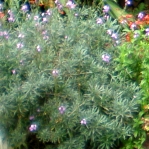Using Herbs from a Home Herb Garden

Herbs have been grown for centuries for culinary use, medicinal use and for various domestic and cosmetic uses.
The plants from a home herb garden are commonly grown for use in the kitchen, both for cooking and for adding to salads, garnishes and dressings. Growing your own herbs allows you to use the freshest possible leaves in your dishes and to replenish your stored herbs often. Many dried herbs lose their aroma over time so that is a big bonus.
Herbs fresh from the garden will give the most pleasure as these are often difficult to obtain just when you need them. Wash them in salted water to drive away insects without damaging the plant. You can dry them in a salad spinner or pat them gently in a folded cloth or between sheets of kitchen paper. Parsley, chives, watercress, coriander leaves (cilantro) and rocket are great in salads.
When using herbs in cooking they should be added sparingly with careful attention to the combinations used. The aim should be to enhance the natural flavour of the food rather than to overpower them. Where you might use a tablespoon of fresh chopped herbs you would substitute about half a teaspoon of crushed dried herbs. Add green herbs towards the end of the cooking time to preserve their colour and flavour. Garlic and tough leaves like bay can be added earlier to permeate the dish. You can make bouquets of herbs to add during cooking which can easily be removed before serving. Bouquet garni is made of parsley stalks, sprigs of thyme, a sprig of marjoram and a small bay leaf. It may be added to soups and stews or put into fowl before roasting. Sauces and omelets are delicious with fines herbs, a classic mix being finely chopped parsley, chervil, tarragon and chives. If you prepare dishes for freezing, remember that aromatic seasonings get stronger when frozen so less is needed. Chopped fresh herbs with a little lemon juice and salt, if you like, can be mixed with butter, patted into blocks and sliced for use with grilled fish or in sandwiches. Parsley, basil, watercress and garlic are among the herbs which work well in savory butters. The possibilities are endless!
More from your Home Herb Garden
We think of herb teas and teas as essentially the same thing. Properly defined, teas are made with the fermented leaves and stalks of plants – often a mixture. The home herb gardener will more often be making tisanes which are made by adding boiling water to fresh or dried herbs. Some herbs need to be infused for longer or even boiled to extract the full flavour. Herbs commonly used as infusions are peppermint, thyme, angelica, chamomile, lemon balm, sage and marjoram.
Medicinal herbs must be used with care. Just because they are natural it does not necessarily follow that they are safe. Any herb can cause unexpected, possibly unpleasant reactions in some people and should only be used for minor complaints by the enthusiastic and informed amateur. As a means to improve health rather than to cure ailments they can be used in moderation to boost immunity and give a sense of well-being. Further study is strongly recommended before proceeding to treat yourself or others.
Herbs are useful around the home too – as pot pourri, to make scented candles – soap wort was used in the past to wash delicate fabrics. You can make scented bags of lavender to hang amongst your clothes or to tuck under your pillow for a good night’s sleep. Horse chestnuts placed with woolen items are said to keep away moths! There is plenty of scope to keep you busy and to experiment with the herbs from your own Home Herb Garden, whether for their taste or their aroma, so enjoy and Have fun!